Parrotfishes (Scaridae)
Parrotfishes are the common names used for the members of Scaridae family. They occur in the Atlantic, Indian and Pacific oceans. They are mainly saltwater fishes. Their teeth are usually fused to form a pair of beak-like plates in each jaw, resembling parrot beak. Most species adults are very colourful. The majority of the species are simultaneous protogynous hermaphrodites. They mature first as females and then sexually transform into males, usually accompanied by a change in colour phase. In species where 2 adult colour phases are known, the first is termed “initial phase” (IP), the second, “terminal phase” (TP). Initial phases may thus be male or female, while terminal phases are invariably male. Many species share common colour patterns especially during their initial phase.
Parrotfishes are difficult to identify. Many species could be identified by their live colouration, but they vary between juveniles and adults and with sex change. The colours also change after death. They are also often being confused as wrasses.
Parrotfishes are most often found on or in the vicinity of coral reefs, and are usually most abundant in shallow waters to a depth of 30 m. They are mostly herbivorous, usually scraping algae from dead coral substrates. Ingested material which includes bits of rock is ground in the pharyngeal mill which reduces it to fine slurry of sand and algae. The sand mixtures help in digestion and also in producing sand on the coral reefs. Some species move over large areas, while others are strongly site attached. They are vulnerable to overfishing, widespread coral reef loss and declining habitat conditions.
There are 10 genera and about 100 species of Scaridae worldwide. Malaysia has at least 6 genera and 27 species.
Parrotfishes are difficult to identify. Many species could be identified by their live colouration, but they vary between juveniles and adults and with sex change. The colours also change after death. They are also often being confused as wrasses.
Parrotfishes are most often found on or in the vicinity of coral reefs, and are usually most abundant in shallow waters to a depth of 30 m. They are mostly herbivorous, usually scraping algae from dead coral substrates. Ingested material which includes bits of rock is ground in the pharyngeal mill which reduces it to fine slurry of sand and algae. The sand mixtures help in digestion and also in producing sand on the coral reefs. Some species move over large areas, while others are strongly site attached. They are vulnerable to overfishing, widespread coral reef loss and declining habitat conditions.
There are 10 genera and about 100 species of Scaridae worldwide. Malaysia has at least 6 genera and 27 species.
Scientific Name: Scarus ferrugineus Forsskål, 1775
English Name: Rusty Parrotfish
French Name: Perroquet ronille
Chinese Name | 鱼类中文名: 鹦哥 (Yīng gē)
Malay Name | Nama Melayu Malaysia: Ketarap, Bayan Karat
Thai Name | ชื่อสามัญภาษาไทย: ปลานกแก้วคางเขียว (Plā nk kæ̂w khāng k̄heīyw)
Size: Maximum total length about 41 cm, commonly to 26 cm.
Habitat and Ecology: Coral and rocky reefs, 1 to 60 m depth. Feeds mainly on benthic algae.

Scientific Name: Scarus ghobban Forsskål, 1775
English Name: Blue-barred Parrotfish
French Name: Perroquet à écailles jaunes
Chinese Name | 鱼类中文名: 鹦哥 (Yīng gē)
Malay Name | Nama Melayu Malaysia: Ketarap, Bayan Belang Biru
Thai Name | ชื่อสามัญภาษาไทย: ปลานกแก้วสีเพลิง (Plā nk kæ̂w s̄ī pheling)
Main Identification Features: Initial phase characterized by 5 blue bars on yellow body as shown in photo below. Terminal phase large, body predominantly pink and 2 bluish green bands on chin.
Size: Maximum standard length about 57 cm, commonly 20 to 40 cm.
Habitat and Ecology: Reefs and adjacent areas, 3 to 36 m depth. Often solitary but may sometimes occur in small groups. Feeds mainly on algae from rocks and corals. This species is protogynous hermaphrodite.

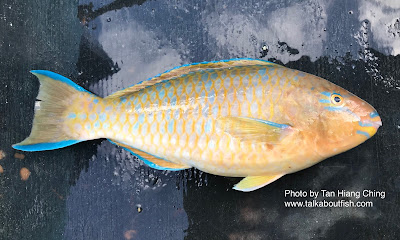
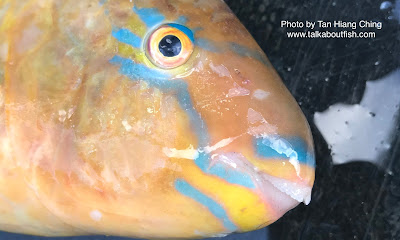
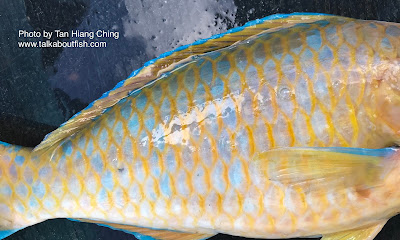
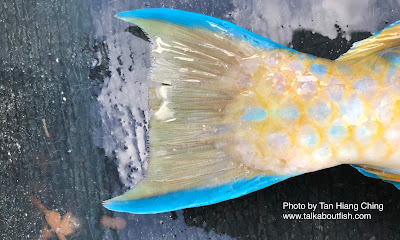
Scientific Name: Scarus rivulatus Valenciennes, 1840
English Name: Rivulated Parrotfish, Scribblefaced Parrotfish
Chinese Name | 鱼类中文名: 鹦哥 (Yīng gē)
Malay Name | Nama Melayu Malaysia: Ketarap, Bayan Coreng
Thai Name | ชื่อสามัญภาษาไทย: ปลานกแก้วคางลาย (Plā nk kæ̂w khāng lāy)
Main Identification Features: Initial phase almost indistinguishable from Scarus quoyi and S. globiceps. Also easily confused with S. chameleon, S. flavipectoralis, and S. psittacus. Terminal phase with distinctive irregular green lines over mouth and snout, posterior part of operculum bright orange as shown in photo below.
Size: Maximum standard length about 40 cm, commonly 15 to 25 cm.
Habitat and Ecology: Coral and rocky reefs to mangrove areas, to 30 m depth. It may form schools with 30 to 40 individuals, often mixed with other species. Grazes on benthic algae and corals. This species is protogynous hermaphrodite.
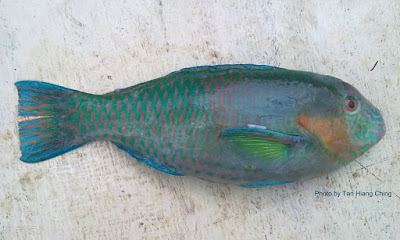
Scientific Name: Scarus tricolor Bleeker, 1847
English Name: Tricolour Parrotfish
Chinese Name | 鱼类中文名: 鹦哥 (Yīng gē)
Malay Name | Nama Melayu Malaysia: Kalat, Perencong, Ketarap, Bayan Tiga Warna
Thai Name | ชื่อสามัญภาษาไทย: ปลานกแก้วสามสี (Plā nk kæ̂w s̄ām s̄ī)
Main Identification Features: Initial phase characterized by dark purple-black body, belly metallic blue, anal fin with orange hue and caudal fin with light red hue. Terminal phase characterized by elongate upper and lower caudal-fin lobes. Terminal phase similar to S. forsteni, differing primarily by having a yellow inner pectoral axil.
Size : Maximum standard length about 26.6 cm, commonly 15 to 20 cm.
Habitat and Ecology: Mixed habitat from coral and rocky reefs to mangrove areas, 10 to 40 m depth. Usually solitary, sometimes in groups. Feeds mainly on benthic algae.
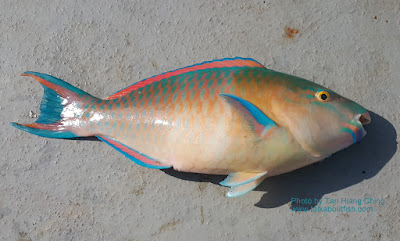

English Name: Rusty Parrotfish
French Name: Perroquet ronille
Chinese Name | 鱼类中文名: 鹦哥 (Yīng gē)
Malay Name | Nama Melayu Malaysia: Ketarap, Bayan Karat
Thai Name | ชื่อสามัญภาษาไทย: ปลานกแก้วคางเขียว (Plā nk kæ̂w khāng k̄heīyw)
Size: Maximum total length about 41 cm, commonly to 26 cm.
Habitat and Ecology: Coral and rocky reefs, 1 to 60 m depth. Feeds mainly on benthic algae.

Scientific Name: Scarus ghobban Forsskål, 1775
English Name: Blue-barred Parrotfish
French Name: Perroquet à écailles jaunes
Chinese Name | 鱼类中文名: 鹦哥 (Yīng gē)
Malay Name | Nama Melayu Malaysia: Ketarap, Bayan Belang Biru
Thai Name | ชื่อสามัญภาษาไทย: ปลานกแก้วสีเพลิง (Plā nk kæ̂w s̄ī pheling)
Main Identification Features: Initial phase characterized by 5 blue bars on yellow body as shown in photo below. Terminal phase large, body predominantly pink and 2 bluish green bands on chin.
Size: Maximum standard length about 57 cm, commonly 20 to 40 cm.
Habitat and Ecology: Reefs and adjacent areas, 3 to 36 m depth. Often solitary but may sometimes occur in small groups. Feeds mainly on algae from rocks and corals. This species is protogynous hermaphrodite.

Scientific Name: Scarus rivulatus Valenciennes, 1840
English Name: Rivulated Parrotfish, Scribblefaced Parrotfish
Chinese Name | 鱼类中文名: 鹦哥 (Yīng gē)
Malay Name | Nama Melayu Malaysia: Ketarap, Bayan Coreng
Thai Name | ชื่อสามัญภาษาไทย: ปลานกแก้วคางลาย (Plā nk kæ̂w khāng lāy)
Main Identification Features: Initial phase almost indistinguishable from Scarus quoyi and S. globiceps. Also easily confused with S. chameleon, S. flavipectoralis, and S. psittacus. Terminal phase with distinctive irregular green lines over mouth and snout, posterior part of operculum bright orange as shown in photo below.
Size: Maximum standard length about 40 cm, commonly 15 to 25 cm.
Habitat and Ecology: Coral and rocky reefs to mangrove areas, to 30 m depth. It may form schools with 30 to 40 individuals, often mixed with other species. Grazes on benthic algae and corals. This species is protogynous hermaphrodite.

Scientific Name: Scarus tricolor Bleeker, 1847
English Name: Tricolour Parrotfish
Chinese Name | 鱼类中文名: 鹦哥 (Yīng gē)
Malay Name | Nama Melayu Malaysia: Kalat, Perencong, Ketarap, Bayan Tiga Warna
Thai Name | ชื่อสามัญภาษาไทย: ปลานกแก้วสามสี (Plā nk kæ̂w s̄ām s̄ī)
Main Identification Features: Initial phase characterized by dark purple-black body, belly metallic blue, anal fin with orange hue and caudal fin with light red hue. Terminal phase characterized by elongate upper and lower caudal-fin lobes. Terminal phase similar to S. forsteni, differing primarily by having a yellow inner pectoral axil.
Size : Maximum standard length about 26.6 cm, commonly 15 to 20 cm.
Habitat and Ecology: Mixed habitat from coral and rocky reefs to mangrove areas, 10 to 40 m depth. Usually solitary, sometimes in groups. Feeds mainly on benthic algae.

